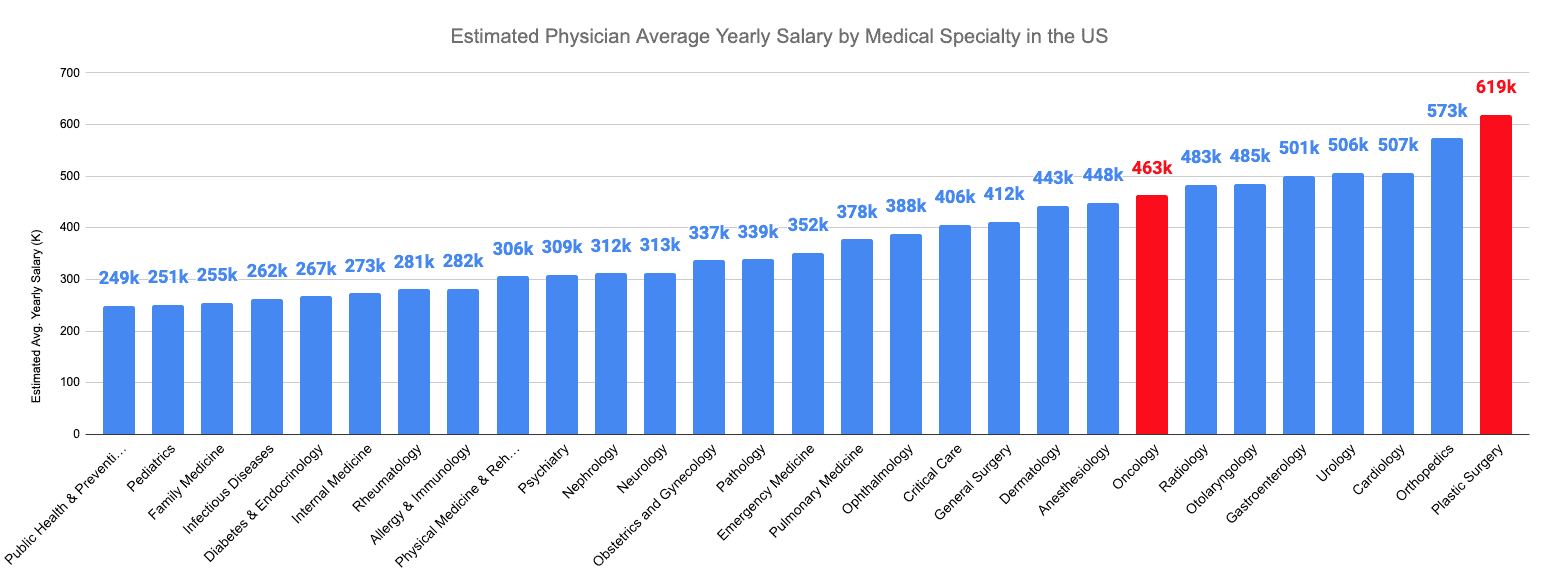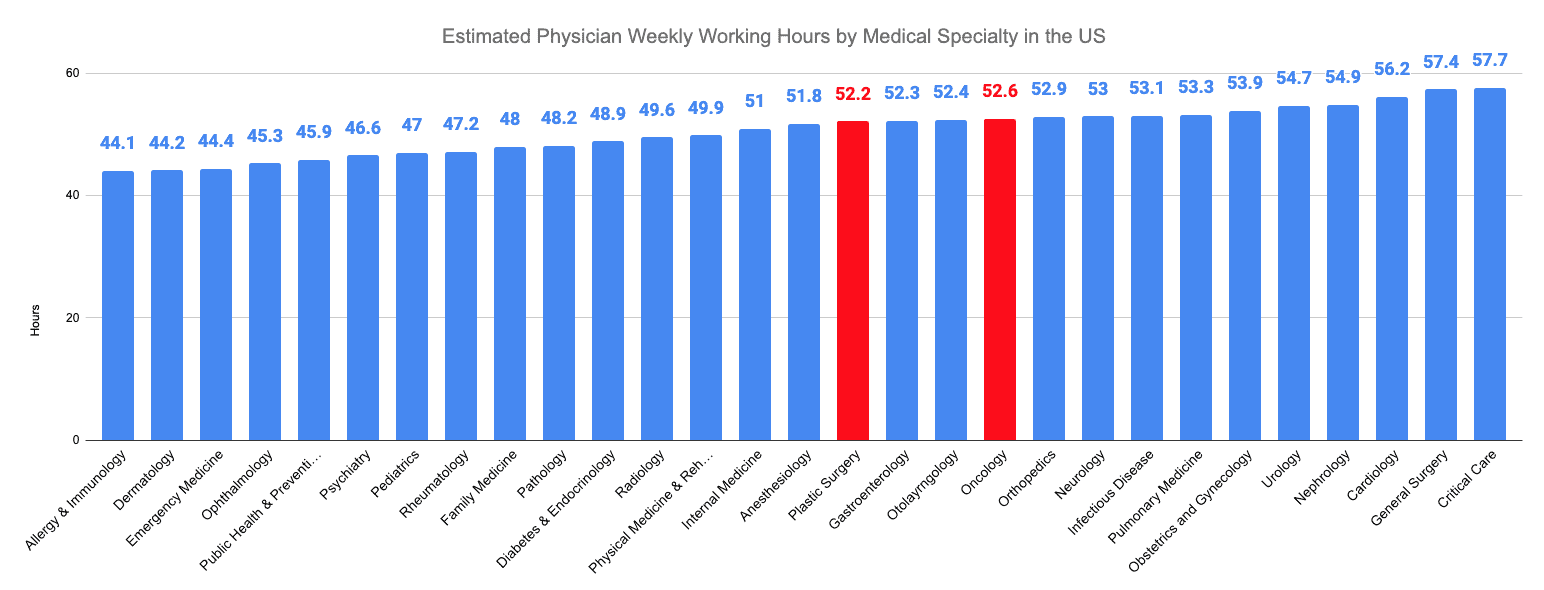
Plastic surgery vs. hematology-oncology is one of the biggest debates among medical students interested in physiology. Both specialties allow you to explore the complex workings of the human body and use your skills to improve patient outcomes. However, they also have significant differences, such as the scope of practice, the work environment, and the training requirements.
How do you decide which one is right for you? In this article, we will provide helpful information and tips to help you make an intelligent decision on plastic surgery vs. hematology-oncology and find a fulfilling career that matches your interests and abilities. We will also help you evaluate practical factors such as job availability, salary, and training duration.
Plastic Surgery vs. Hematology and Oncology: Salary and Job Security
Plastic surgery might be your specialty if you want to earn a lot of money and have a steady demand for your services. But be prepared for a competitive job market after fellowship, even if you graduate from a prestigious program.
Hematology-oncology, meanwhile, offers more job openings. You can easily find a hospital that needs hematologist-oncologists, and the career outlook is positive, even if the salary is not as high as plastic surgery. But hematology-oncology also come with some challenges, such as higher burnout, which we will discuss later.
According to recent data, plastic surgeons have the highest average annual salary among medical specialties at $619,000, while hematologist-oncologists earn less with an average of $463,000.

Plastic surgeons earn $619,000 per year on average, while hematologist-oncologists earn less with $463,000 annually
Plastic Surgery vs. Hematology and Oncology: Competitiveness
Here we can assess the competitiveness of a specialty by looking at the unmatched rate – the % of people who apply and do not match their preferred specialty. Plastic surgery was the most competitive residency in the 2022 Match, with a 37.3% unmatched rate among US Seniors.

Internal medicine had a 2.0% unmatched rate, while plastic surgery had a 37.3% unmatched rate among US seniors
To pursue a career in hematology-oncology, you must first match into an internal medicine residency. Among US Seniors, the unmatched percentage for internal medicine residency was only 2%, making it less competitive than other residencies. However, this does not mean that hematology-oncology is less competitive. After completing your internal medicine residency, you will still need to match into a fellowship, which is generally more competitive than matching into a residency.
Below is the unmatched percentage among non-pediatric fellowships with >100 applicants. The unmatched percentage of US Seniors applying to the hematology-oncology fellowship was 11.9%, making it moderately competitive compared to most fellowships with >100 applicants.
Training Path: Residency vs Fellowship
Plastic surgery requires completing a five to six-year residency program accredited by the Residency Review Committee for Plastic Surgery (RRC-PS). To become a hematologist-oncologist, you must complete a three-year fellowship in hematology-oncology after completing an internal medicine residency.
A hematology and oncology fellowship is usually less competitive than a plastic surgery residency. Your USMLE scores, med school, and research are the main things for residency applications. Research is also a big thing for fellowship applications, and your residency program counts more, but your USMLE scores matter much less.
Plastic Surgery vs. Hematology and Oncology: Work-Life Balance
Work-life balance is a crucial factor for many medical professionals. Hematologist-oncologists often work long hours, including on-call shifts, and may face emotional challenges due to the nature of their work with cancer patients. Similarly, plastic surgeons often have demanding surgical schedules and may work long hours in the operating room. They may also be on-call for emergencies such as trauma or burn accidents.
On average, plastic surgeons and hematologist-oncologists work 52.2 and 52.6 hours per week, respectively, ranking them in the middle of medical specialties.

Plastic surgeons work an average of 52.2 hours per week, while hematologist-oncologists work slightly more hours, at 52.6 per week.
Plastic surgeons spend an estimated 11 hours per week on administrative paperwork tasks, such as documenting pre- and post-operative notes and taking photographs. In comparison, hematologist-oncologists spend more hours, approximately 18 hours per week, due to extensive diagnostic and follow-up tests.

Plastic surgeons spend around 11 weekly hours on administrative tasks, while hematologist-oncologists work more hours, at 18 per week.
Training Duration and Subspecialties
The training duration is a key aspect to consider when choosing between plastic surgery vs. hematology-oncology. Hematology-oncology has a six-year training period, while plastic surgery has a minimum of five to six-year residency program.
After completing a plastic surgery residency program, some surgeons may choose to pursue additional fellowships to further specialize in a particular aspect of plastic surgery. This can increase the length of your plastic surgery training.
Plastic Surgery vs. Hematology and Oncology: Job Satisfaction and Burnout Rates
Job satisfaction plays a significant role in career fulfillment. According to various studies, both plastic surgeons and hematologist-oncologists tend to have high job satisfaction rates, with many professionals expressing contentment with their career choice and would choose it again if given the chance. However, plastic surgery has lower reported burnout rates than hematology-oncology.
According to recent data, both plastic surgery and hematology-oncology are highly ranked among medical specialties, with 97% of plastic surgeons and 94% of hematologist-oncologists stating that they would choose the same specialty again.

Plastic surgeons reported a job satisfaction rate of 97%, while hematologist-oncologists reported a slightly lower satisfaction level at 94%
That being said, the burnout rate for plastic surgery was 46% which was near the lower end of all medical specialties. In comparison, hematology-oncology had a burnout rate of 52%, ranking in the middle of all medical specialties.

Plastic surgeons have a burnout rate of 46%, while hematologist-oncologists have a higher burnout rate of 52%.
Plastic Surgery vs. Hematology and Oncology Comparison
To provide a visual overview, here’s a table comparing plastic surgery and hematology-oncology:
| Aspect | Plastic Surgery | Hematology and Oncology |
|---|---|---|
| Average Salary | High income, especially in specialized areas like reconstructive or cosmetic surgery | High but lower than plastic surgery |
| Job Security | Stable field with availability of both reconstructive and cosmetic procedures | High demand due to the prevalence of blood disorders and cancer, aging population |
| Training Path | Typically involves 5-6 years of plastic surgery residency | Typically involves 3 years of internal medicine residency followed by a 3-year hematology-oncology fellowship |
| Lifestyle | Generally predictable work schedule and increased opportunities for time off, but may involve on-call responsibilities for trauma or burn cases | More predictable work schedule and increased opportunities for time off, but may involve on-call responsibilities |
| Administrative Paperwork | Low to Moderate documentation requirements for patient records and surgical plans | Higher documentation requirements including detailed patient records and treatment plans |
| Job Satisfaction | Generally high, satisfaction tied to successful surgeries and patient outcomes | Slightly lower |
| Burnout Rates | Low to Moderate, depending on the workload and stress associated with surgical procedures | Higher |
| Personality | Requires creativity, precision, and good communication skills, attention to aesthetics | Strong analytical skills, empathy, ability to deliver difficult news, handle emotional situations |
Please note that this table serves as a general comparison. To determine the most suitable career for you, consider your personal and career priorities and goals.
Concluding Thoughts
Choosing the right specialty between plastic surgery vs. hematology-oncology depends heavily on your priorities. To determine this, try reverse engineering your ideal life and identify your top priority. A helpful exercise is to write down the top five things you want to achieve in your career and personal life. Knowing these priorities will make finding a career that aligns with them easier. Often, the biggest obstacle is not a lack of knowledge about different fields but a lack of self-awareness about our preferences.








